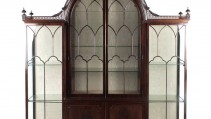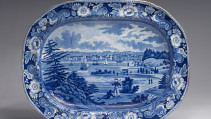What to buy now? Experts reveal unexpected prime collecting opportunities
TEXT BY CHRISTOPHER MASON Posted December 14, 2015
Peruse the auction records of late and it’s clear that everyone who’s anyone can’t get enough of modern and contemporary art and midcentury furniture. Jean Prouvé tables and pairs of Arne Jacobsen floor lamps now trade hands for around a million dollars, while one of Jeff Koons’s Balloon Dog sculptures holds the auction record for a living artist at $58.4 million. And this obsession with modern, contemporary, and midcentury—call it M.C.M.—shows few signs of letting up anytime soon.
“Basically 90 percent of everything mankind has created over the centuries is being overlooked,” grumbles one antiquaire who wishes to remain anonymous. And with the big money focused on marquee names, the ranks of the underappreciated are expanding to include all manner of desirables, among them African masks, antique French papiers peints, Victorian furniture, even plenty from the 20th century.
“Nothing remains undiscovered,” cautions Hervé Aaron, president of Didier Aaron, the New York, London, and Paris gallery, “but there are neglected designers.” Consider Daniele Lovati, an obscure Mila nese cabinetmaker active in the late 19th century. A couple of years ago Aaron stumbled across a bargain-priced Lovati secretary bookcase—resembling a campanile and inlaid with ivory—and flipped it to Paris’s Musée d’Orsay last summer for somewhere in the mid-six figures.
Genres fall in and out of style, and right now traditional English furniture, all the rage in the 1980s, elicits yawns. On October 27 at Christie’s in New York, the Metropolitan Museum of Art deaccessioned more than 200 largely Georgian relics. A wacky George II mahogany armchair, likely of Irish origin, was top lot, selling for $437,000, though numerous pieces clocked in at less than $30,000. The Met’s imprimatur almost certainly helped because English antiques and lackluster results frequently go hand in hand. In April at Sotheby’s London, eight stunning George III dining chairs in faux Macassar ebony sold for $3,084—which averages out to just under $400 per seat.
Also depressed due to the vagaries of fashion is 18th-century French furniture. A pair of Régence walnut armchairs once owned by style icon C. Z. Guest brought $1,625 at Sotheby’s New York in October. Most European portraits of the era lag, too, as does early-American portraiture, says Manhattan art dealer Debra Force, “unless the subject is a major historical figure.”
When it comes to Asian artifacts, Brussels dealer Gisèle Croës says that earthenware from the Neolithic period and the Han and Tang dynasties has been “selling at auction for very low prices, often because the market has been flooded with pieces of uneven quality.” A case in point are Tang funerary horses. Things of beauty made more than 1,000 years ago (their age should be authenticated through thermoluminescence), they remain plentiful and can sometimes be bargains. In October at Bonhams in San Francisco, a Tang steed, its painted finishes worn by time, went for just $1,250.
Japanese woodblock prints known as Ukiyo-e represent an other “market inefficiency,” according to New York antiques dealer R. Louis Bofferding. Take the online auction of Japanese prints that Christie’s hosted last spring. Hammer prices ranged from about $27,780 for an 1885–92 edition of Tsukioka Yoshitoshi’s legendary One Hundred Aspects of the Moon all the way down to around $185 for an 1867 Chokaro Yoshiiku mo portrait of actor Otani Hiroji V. Things could change, though, especially given the recent blockbuster exhibitions dedicated to Ukiyo-e master Katsushika Hokusai—one at the Grand Palais in 2014–15 and another at the Museum of Fine Arts, Boston, that closed in August—as well as the expected fall opening of the SANAA-designed Sumida Hokusai Museum in Tokyo.
“Shows create a cachet, so you get the attention of people who decide it’s time to investigate a particular area,” says Cole Harrell, a Manhattan tribal- and Oceanic-art adviser. Casting a bright light on Central African art in recent months is the Met’s “Kongo: Power and Majesty,” on view through January 3, but Harrell says that works from Angola and Tanzania “are in a quiet period, saleswise.” His stock includes a haunting early-20th-century Chokwe mask from Angola depicting a young beauty with facial scarification and springy braids. It’s tagged at $25,000, though auction results suggest it might have gone for twice that a few years ago.
When Manhattan’s Whitney Museum of American Art opened its new downtown home last spring, the inaugural show, “America Is Hard to See,” reminded visitors of the key roles played by less-heralded figures such as early modernists Arthur Dove and Earl Horter, whose price points have lagged far behind those of the Abstract Expressionists and Pop artists who followed. And it may surprise some art lovers, but Stuart Davis’s vibrant early abstract paintings have languished for as long as anyone can remember.
M.C.M. ardor has dented the Old Masters market as well. Bob Haboldt, a charismatic Dutch expert with galleries in Amsterdam, Paris, and New York, notes that large decorative portraits by lesser-known names like 17th-century artist Pieter Nason can be purchased for under $100,000.
There’s no shortage of buyers for readily identifiable urban scenes painted by such famous 18th-century Venetians as Canaletto and Francesco Guardi. But Marco Ricci, a contemporary, turned out fascinating if currently little loved capriccios—landscapes that blend fantasy, reality, and allegory. As Haboldt says, they are “bound to come back into favor when the current minimalist tendency to only consider stark and early pictures has peaked.”
Other intriguing landscapes can be found in early-19th-century scenic wallpapers, hand-blocked by the studios of masters like Joseph Dufour and today typically framed as sections rather than pasted onto walls. “Few people know this field well, but the works make such a statement,” says Paris- and New York–based expert Carolle Thibaut-Pomerantz. The price range? At Manhattan’s recent International Fine Art & Antiques Dealers Show, Thibaut-Pomerantz offered large polychrome panels teeming with aboriginal royalty from Dufour’s Les Incas for $65,000 each.
“We’re not generating many new collectors in premodern American art and furniture, either,” says Debra Force. So now is an ideal time to pick up the paintings of Gilded Age American artist Mary Cassatt (“suffering dramatically”), Hudson River School stars such as Asher Durand (“selling for half what they used to”), and Boston and Old Lyme Impressionists (“either the major collectors aren’t collecting anymore or they’ve died”). And, she adds, the wonderful works of California Impressionists of the early 1900s “are still really collected only by Californians.”
Even M.C.M. admirers have plenty of opportunities on the fringes. Richard Wright, president of Chicago’s Wright auction house, points to the weblike sculptures of Claire Falkenstein, an American artist who wrought monumental Murano-glass studded gates for collector Peggy Guggenheim’s Venetian palazzo in 1961.
“Falkenstein’s work is really strong, but it never seems to bring what it should,” says Wright, who last February sold a tangly tabletop structure of welded copper and fused glass that was made about a decade after the Guggenheim commission. It brought $18,750, a steal considering that her larger works go for about four times that. The auctioneer also suggests revisiting George Nakashima furniture, which sold in the high hundreds of thousands before the most recent global fiscal crisis, saying that “in many cases you can get pieces for half the price they were in 2007.”
In the end, personal interest is what matters, especially for dedicated buyers. “To be a true collector means becoming a connoisseur,” Aaron says. “And that means being more specialized and searching for things other people will not realize are important.”
Source: Architectural Digest





